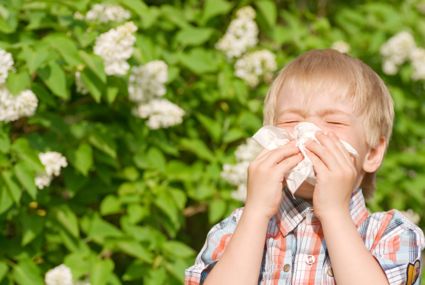Sniffles, Sneezes, and Spring Allergies in Kids
Does your child have a stuffy nose and itchy, watery eyes? Is she sneezing a lot?
Spring is in the air, and so are billions of tiny pollens that trigger allergy symptoms in many people. Children with allergies and asthma often suffer much more than just physical symptoms like sneezing or shortness of breath. Kids with allergies can experience emotional stress, sleeping difficulties, academic troubles and peer conflicts.
If this sounds like your child, now is the time to schedule a visit with your child’s pediatrician or an allergist. Here are five things you should know about spring allergies. Click here to read more.
1. Know the symptoms.
Is that “achoo” seasonal allergies or a cold? Sneezing, nose and throat itchiness, and eye itchiness plus redness usually signal allergies. Like a cold, allergies produce nasal drainage, but it looks clear and watery. With a cold, mucus drainage is thicker and yellow or green. Keep in mind that the symptoms varies from child to child — one may have more sneezing, another more of a runny nose, another more of the “itchies.”
2. It matters when you medicate!
Pollen season can start as early as February here in the Deep South. If your child suffers spring allergies, ACAAI recommends starting her medication two weeks before her symptoms typically begin. While no “cure” exists for spring allergies — nasal sprays, inhalants and oral OTC antihistamines can help manage her symptoms.
3. Allergies can trigger or worsen asthma.
Allergies and asthma often go hand in hand. While the triggers vary from person to person, pollen is one of the most common substance that causes allergic asthma. Other triggers include dust mites, molds, pet dander, and even (yuck!) cockroach droppings. If your child is coughing, wheezing, or having trouble breathing, carefully monitor her symptoms and talk to your child’s pediatrician.
4. Pollen Avoidance
To reduce your child’s exposure to the things that trigger her allergy symptoms, do the following:
- Keep your child indoors on dry, windy days — the best time to go outside is after a good rain, which helps clear pollen from the air.
- Keep your house and car windows closed to keep pollen out. Create a pollen-free zone in your child’s bedroom.
- Consider a HEPA filter on central air conditioner units or a personal air filter to cut indoor pollen.
- Shower and wash your child’s hair before going to bed after outdoor play.
- Grass and weed pollen tend to peak in the morning, so plan outdoor play toward evening when possible.
5. When in doubt, get checked out.
If avoidance and medications don’t adequately manage your child’s symptoms, talk to your child’s pediatrician or an allergist about allergy immunotherapy. Find out exactly what your child is allergic to, and develop a plan.
Source: American College of Allergy, Asthma & Immunology (ACAAI)



